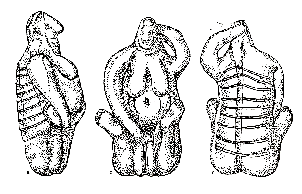Here is a rare chance to see a programme about women in prehistory and their place in religious development, fronted by Betany Hughes (again). Hold on tight, because it really rattles along, having been given the task of condensing a huge subject into only a few hours TV. So, lets not knock it too much. I will have a look at the rest of the series and hope that all the gaps are filled, to a greater or lesser degree. Also, it is becoming easier to ignore the usual 'filler' shots of Hughes against a setting sun, or walking across a landscape, or.... etc etc.
 |
| Golbekli Tepe carving |
So here we have a very early site (Mesolithic), possibly a temple, with a female carving, which is possibly the first evidence of 'organised' religion. Hughes had mentioned in passing that female figures have been carved from the Palaeolithic, then passed on immediately to the Mesolithic without any more reference to it.
 |
| Venus of Willendorf 24k-22k BCE |
That may be in the next programmes. But that did not put the following information into context. That context is one of many thousands of years of female carvings created during the Palaeolithic and as such leaves the rest of the information in the programme 'hanging'. Also, just because the people of the Palaeolithic did not possibly leave structures (temples?) does not mean that they did not have an 'organised' religion. That would mean that Druids did not have an organised religion.
At Catal Hoyuk, again in Turkey (directed in the field by my old colleague from Passmore Edwards Museum days, Shahina Farid), this early Neolithic site had many female figures and bulls carved and painted in the dwellings. No other mention was made of the bull connection to the female figures (important for this site and its interpretation). Shahina makes a very interesting statement about how the female burials show that they were 'skinny', whereas the female figurines are, what would now be termed, clinically obese. Shahina is, as usual in the profession, loathe to mention the G word in relation to the figurines, but the fact that they are fat and the real women thin may indicate that they are representations, not of 'ideal' real fertile women, but the goddess of all life, as at Gobekli Tepe and the figurines from the Palaeolithic. I cannot believe that Shahina has not heard of the earlier figurines, so can only surmise that she has dismissed any connection to them and her site, which she states is the 'beginning of the goddess form'. I would disagree (by a few thousand years!).
One figure that I had never seen before, from this site, was this one:
It shows a woman plump in front and as a skeleton behind. Striking and a bit unsettling. I was immediately struck by the similarity of the figurine I have shown before - this one, the so called 'birth goddess':
 |
| From Tarxian, Malta |
I think that sometimes being a professional, with responsibilities and a fear of reputation being trashed, can suppress thinking and interpretation too much. One must always be looking over ones shoulder in case of ridicule and loss of face (and job). Luckily no one returns from the past to make fools of us all. But wouldn't it be wonderful?

I disagree. The figurines of women showing their insides remind me most of a toy my sister had - The Visible Woman - http://www.amazon.com/The-Visible-Woman-Model-Kit/dp/B004ZEUNJA
ReplyDeleteFigurines can be play dolls, instructional dolls, porn, or any number of things other than goddesses.
And most cultures I'm aware of do not have souls returning to a mother figure - even where they have a mother goddess. They either get shunted off into a anteroom of existence, hang around to annoy the relatives, or get condemned to eternal boredom.
Where mother goddesses exist, they are often many and not one idealised: Gaia, Demeter and Kybele were not aspects of the same goddess but rival antagonistic cults (see http://en.wikipedia.org/wiki/Category:Greek_goddesses) , as was Danu, Brigid, Badb... see http://en.wikipedia.org/wiki/Category:Irish_goddesses They were totemic and individual, not expressions universal attributes.
Dave, I think that you disagree with something I have not said. I do not think that all 'cults' where women are portrayed are representing the same goddess, in their eyes. They are just manifestations of an earlier theology. Look at Christianity, Judaism and Islam - basically the same religion but now fragmented by later schism, both as a body and internally. Outside of fanatics no one would think that they are praying to a different god. They are the 'people of the book'. The goddesses are individual and possibly totemic, but like Kybele they are seen as the guardian of the dead and goddess of fertility and wild life. A Homeric hymn is to the nameless 'Mother of the Gods':
ReplyDeleteMother of all the gods
the mother of mortals
Sing of her
for me, Muse,
daughter of mighty Zeus,
a clear song
She loves
the clatter of rattles
the din of kettle drums
Humans are humans and do have universal attributes - they just express them in many ways, now and in the past.
Well, having looked up the dieties you mention I am struck by these points:
ReplyDeleteDanu - a water goddess; Proto-Indo-European 'danu=fluvial water or running water.
[So many references to water are associated with a goddess from much earlier they are to many to mention]
Brigid - said to have 2 oxen and healing powers.
[Oxen are seen at Catal Huyok etc. in association with the goddess + the healing of waters]
Badb - predicts death - has 2 sisters Macha & Morrigan.
[The death aspects includes also the 'maiden' and the child; also the three witches]
If they are not connected by thousands of years of development from a core theology I give up.